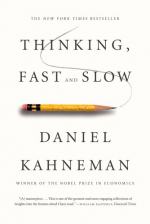
|
| Name: _________________________ | Period: ___________________ |
This quiz consists of 5 multiple choice and 5 short answer questions through Chapters 10 - 14.
Multiple Choice Questions
1. What branch of medicine deals with the incidence, distribution, and possible control of diseases and other health factors?
(a) Psychiatry.
(b) Epidemiology.
(c) Biology.
(d) Psychology.
2. Who introduced the labels System 1 and System 2 as systems of the mind?
(a) Larry Jacoby.
(b) Keith Stanovich and Richard West.
(c) Mihaly Csikszentmihalyi.
(d) Nassim Taleb.
3. Cognitive strain is defined by the author as being affected by both the current level of effort and what?
(a) The presence of unmet demands.
(b) The probability of future expectations.
(c) Levels of intelligence.
(d) Cognitive Pupillometry.
4. What do we lose touch with when we are uncomfortable or unhappy?
(a) Intuition.
(b) Recognition.
(c) Admiration.
(d) Articulation.
5. Who used a method to test intentional causality by making a film in 1944 that involved a circle and two triangles?
(a) Fritz Heider and Mary-Ann Simmel.
(b) Danny Oppenheimer.
(c) Shane Frederick.
(d) Daniel Gilbert.
Short Answer Questions
1. What example is presented in the opening of Chapter 1 to demonstrate slow thinking?
2. In the aphorisms presented by the author in Chapter 5, what aphorisms were judged to be more insightful to study participants?
3. What comparison does the author make between six-year-old boys and six-year-old girls in Chapter 10?
4. Who coined the term "mere exposure effect"?
5. What term refers to the study of pupils in relation to the mind?
|
This section contains 262 words (approx. 1 page at 300 words per page) |

|




